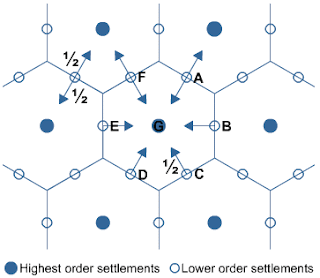Christaller introduced the conceptual framework that is
Central Place Theory (CPT) in 1933. Central Place Theory essentially states
that if an area of land is flat and featureless and there is an even
distribution of population, as well as equal money and transport opportunities,
then settlements will follow a distribution pattern according to their size. CPT
attempts to illustrate the concepts of threshold and range of settlements, how
settlements locate in relation to one another as well as dealing with hierarchy
of settlements.
Threshold and Range
The minimum sales that an establishment must secure in order
to survive is the threshold population. The relationship between threshold
population and number of establishments is exponential (similar to y=e-x).
The range is the maximum distance the population is prepared
to travel to purchase goods from a central place. This will be different for
convenience and comparison goods, in general people are willing to travel
further for comparison goods than they are for convenience. Hence convenience
goods will have a short range and comparison a long range.
Hierarchy
This is exactly what I mentioned about in the ‘Rural
Characteristics’ blog post when I spoke about the function and hierarchy of a
settlement. Hierarchy is essentially made up of three steps: first, the higher
order settlements are generally larger in size and offer more functions;
second, higher order settlements occur less frequently, and as such, are spaced
further apart. Finally the hierarchy is stepped as can been seen in the graph
in the ‘Rural Characteristics’ blog post.
Nesting
This is the main part of central place theory that the
S-cool website goes into. Each settlement is surrounded by a market area it
serves. The largest settlements are found at the centre of the hexagons and are
surrounded by smaller settlements. The larger the settlement, the greater the
market area. The idea is that people from the small villages will only visit
their large settlements for anything not provided by the village - they cannot
cross the boundaries.
The distribution of nesting will follow one of three
patterns: Firstly, Market Optimising. In this pattern, shoppers in the smaller
settlements divide into three equal groups when shopping in the three larger
settlements.
Second: Transport Optimising. Shoppers in the smaller
settlements divide into two equal groups when shopping in the two nearest large
settlements.
Third, and finally: Administration Optimising. All shoppers
in the smaller settlements shop in the nearest large settlement.
References
Nagle and Spencer, 1997. Advanced
Geography Revision Handbook. Oxford University Press.
http://www.britannica.com/EBchecked/topic/102569/central-place-theory
http://www.s-cool.co.uk/a-level/geography/urban-profiles/revise-it/central-place-and-bid-rent-theories



No comments:
Post a Comment